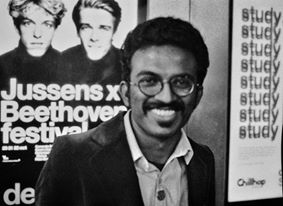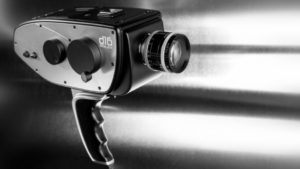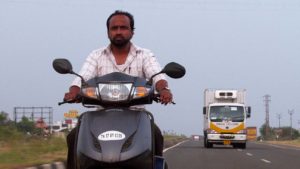
Nasir: Indie film by ARUN KARTHICK
Jun 20 2020
Arun Karthick a Coimbatore born with conviction to make Independent films he discontinued his Engineering education to make serious films that he wanted to pitch internationally.

His first was a short film named ‘The Back Waters’ in Malayalam made during 2008-09 shot by cinematographer C.J.Rajkumar which was firsts of DSLR cinematography in India. This short film won many accolades at various international film festivals captured heart of great film makers like Adoor Gopalakrishnan, Prasanna Vithanage(Srilanka).
Then he went on to make Independent feature films. Tamil film ‘Nasir’, director Arun karthick narrates an intimate portrait of a working-class Muslim man in Coimbatore, going about his day. Nasir navigates the labyrinthine streets around Town Hall, we, too are pulled in to experience the smiles, frowns and the religious bigotry that he witnesses as a Muslim man.
a few hours after its screening at the We Are One online film festival which streamed for one full day made many cine lovers to watch it and appreciate Nasir, which won the prestigious NETPACaward for the best Asian production at the International Film Festival of Rotterdam.
Ace Director/Cinematographer Rajiv Menon made a call to this young filmmaker and gave his views.

Karthick’s adaptation of Dilip Kumar’s short story A Clerk’s Story unfolds as a day in the life of Nasir, a Coimbatore resident with a humble job, dreams in his head and poetry in his heart. As we follow him from dawn to dusk, the screenplay yields mundane and yet rich details of Nasir’s modest existence – his ardour for his wife, his love for his mentally challenged son, his dedication to his work, his attempts to plan a better future. Big hopes and small pleasures co-exist in a harmony undone by rising Hindutva sentiment.
ARUN KARTHICK as a film Director shares his visual journey with SICA.
How did you begin your journey?
I come from a film society background. There was one called Konangal in Coimbatore. It was exhibiting world cinema for more than 10 years. When in Class 11, I chanced upon an Italian film called 8 1/2. Though I couldn’t understand anything, the images stuck with me for weeks and created unfathomable feelings. That experience led me to watch more such movies, and I was fascinated by the vastness of it all. This was the starting point.
You stayed in a Muslim locality in Coimbatore while making the film.
After the 2016 riots, when I decided to make this film, I rented a place in the Muslim neighbourhood even though I am from Coimbatore. Some years ago, there had been bomb blasts on that street, which affected Hindu-Muslim relations. I wanted the film to be set there because the short story on which it is based—A Clerk’s Story by Dilip Kumar—is also set there. Living there for almost three years helped me scout locations and get the right texture and flavour for the film. Besides, the people there were not quite accepting of cinema. So I mingled with them, told them I was writing a story that I might turn into a film. Once they got to know me, it was easy to check out houses and shops where we could shoot. Considering that we were shooting the film in 20 days and the area is extremely crowded, we needed to have a good understanding of the space. We did not have the bandwidth to block streets like regular film shoots, so we had to be as invisible as possible.
You have worked with cinematographer Saumyananda Sahi and editor Arghya Basu on your first film as well. How was the experience of collaborating with them on Nasir?
It was fascinating. We started talking about the film as soon as I started writing it. We did not want to make a hero out of Nasir, but at the same time, wanted to show some of his simple qualities that are not much talked about. We discussed how to construct his ordinariness. A lot of interesting conversations ensued, especially about what freedom means. Sahi said freedom is choice and agency, while Basu argued that freedom means choosing your battles. Discussions like these helped us choose the camera. We used a Digital Bolex, a limited-edition camera that has to be worked a certain way. There are many difficulties in shooting with it, but Sahi felt there must be some negotiation between the method and the tool. This helped us create the reality of the film. We had many such conversations about the sound, the spaces we would portray and how our protagonist would traverse the different spaces. These discussions gave us insights into how we see the film and how we want others to see it.
To start with, could you tell us the choice of 4:3 aspect ratio for the film and particularly the curved edges?
It was a concrete decision that we wanted to go with this aspect ratio and it was not meant for any style. We want to tell the story like a portrait and even though the film has a realistic story telling. we don’t want to make the audience see in a wider ‘aspect ratios’, as like our common eyes see. This avoids naturalism and the audience should feel the film like a tale. Thus, myself and cinematographer Saumyananda Sahi zeroed in this aspect ratio and even we have introduced a small curvature during the post, to give a sense of unrealness to the story.

Interesting. We have heard you have used a unique Digital Bolex to shoot the film? Why was this decision?
The venue, where the story happens consists of different dress shops having a lot of colour space and we were looking for a camera which captures those colours fully. After initial tests we have found that the Super 16mm Digital Bolex camera seemed to deliver the output we want, since it is the only digital camera which gives RAW pixel readout from sensors without any compression from the image processor, with CinemaDNG format. The camera has a Super 16mm Digital CCD sensor from KODAK and it is designed based on the colour science of their motion picture films.

Why was the deliberate choice of going for a CCD when we are in the era of CMOS sensors and there are some downsides when we go for a CCD sensor.How did you manage it ?
As said earlier, we liked the concept of pure RAW data which has zero processing and it has huge 12 bit depth quality and it doesn’t have any no noise reduction process too. Thus we would be able to get the most dynamic range and we will be extracting the data only at the time of post-processing.
Yes, CCD has some downside of blooming effect and vertical smears, where we will be having an overexposed streak of light created across the pixel-when we expose the sensor with strong moving lights. Thus we carefully avoided such shots and one other downside is the camer’s maximum resolution is 2K. But we felt as most of the films have been screened in 2k even DCI has close to 2K resolution. So we felt this resolution was enough for the screening.
lso, we have heard that you have almost shot in ISO 100 for maximum scenes ?! Also, could you elaborate the choice of lenses you have used.
Yes, indeed. We have done extensive tests using the camera and we felt its 7 stops dynamic range was more sufficient for the film and the only constraint was, we have to expose with proper exposure. Also, the camera manufacturer claims that the camera gives more shadow details when we shoot at ISO 100 and when we go for ISO 400, it gives more details in highlights. Thus we have used ISO 100 for all the interiors and for very few outdoor shots we have used ISO 400 coupled with ND’s to create the contrast. Also, we feel the camere reproduces the very natural skin tones and strong blacks.
Regarding the lenses used in the film, we have two C mount(Screw mount) & PL mount and we tried different super 16 lenses of Kodak, switar. But we were looking for Zeiss Super speed lenses, because I specifically like its 3-bladed aperture, its colour coating, sharpness and it handles the colours very neutral. But it was not available readily at the commercial front and luckily we got to know that Cinematographer-Director Manikandan(Kakka Muttai fame) owns 4 sets of Zeiss Super speed lenses(Mark III) for super 16mm.
Then we got the lens sets from him and additionally we got a special Zeiss Super speed Zoom Lens (10-100mm) which has the crop factor of around 3.0, giving a field of view of 300mm(like in 35mm). We used this zoom lens for one particular shot where the protagonist will be talking with a guy amidst a very busy background. This lens specifically helped us to shoot the scene from a very long distance.
Could you tell us about the lights you have used in the film ?
Since we have fixed to shoot in ISO 100 definitely we were in need of enough lights and we thought Tungsten light would do better for the sensor and for truthful colour reproduction. Wherever possible we have used tungsten lights & few HMI’s and we have used a skypanel as a fill light. For the textile shop portions we thought of using a series of household Tungsten lamps(100W), but unfortunately it was not available instantly. After a search we have found those and we have used it for the scene.
HHow did you handle the RAW file (CinemaDNG) in Post-Processing ? Have you used any LUTs? Also, we got to know that you have got a special grant for DI colour correction in the Netherlands. Tell us your experience in that.
Our recording format was CinemaDNG and we have got three preloaded LUT’s in the camera- Bolex Gamma, Rec. 709 & Log.We have used these LUT’s to check the exposure levels and we have used a professional monitor to view the output. For the post-Production we have got a special grant from Netherlands to do the film’s Sound Mixing & Colour grading. We were provided 40 hours to grade the footage and since the cinematographer Saumyananda Sahi has exposed very perfectly we didn’t have much work in correcting the exposures through post.
We have used DaVinci for colour grading and we have graded with the LUT provided by Bolex. We started the grading using that LUT and we were only concentrating the black & whites. We made whites more whiter and black more black and I was very specific to have a bit grainy look for the film. Thankfully the camera itself has generated organic grain we needed (thanks to the absence of noise reduction process in the camera), we followed the scheme for the whole film.
You seem to be an avid fan of collecting Cameras and lenses. And you own some of it also. Do you think it is necessary to own equipment as an independent filmmaker?
Yes absolutely. I feel it is necessary for every filmmaker to understand the imaging process of how every camera and lens works & behaves with lights and colours.So that we know clearly how far we can use the technicalities in the film to narrate a visual story. That is the reason I have been procuring equipments for myself and I have a good collection of old Super 16mm, 8mm cameras, vintage lenses, few filters and few entry level DSLRs. I have been collecting equipment from worldwide- through ebay like platforms and i strongly believe it is very important for independent filmmakers to own such foundry. Because this will give freedom to explore, experiment and I also think we can largely save the rental expenses for the film. So that we could save the money and can use that money for other purposes.
Applying or approaching for film grants is a new way to get funds for your films as an Independent filmmaker. Could you tell us in brief about its process, benefits and tips to apply for it.
We know that a lot of film festivals are happening althrough the world and quite a lot of film grants are equally available to fund your project. Only thing is they demand concrete details about the script and even have a specific format to apply for the grant. For example, you need to submit the Log-line,Plot-line, Synopsis, treatment of the script in prior, fulfilling the rules and regulations cited by them. Even we need to send them about our previous works & the budget plan. From the above mentioned details it will be reviewed by a committee and then they allocate the grant. The grant fund should not necessarily be ‘money’, but they can offer you any sort of free service equal to the money, where we can use those services for our film.This is how I got the grant from the Netherlands to do my sound mixing & Colour grading.
Also, I recommend filmmakers to write the above things truest to them, even in their own language and you can later translate it into English.

Drafted by Gowrishankar (Lecturer Cinematography)
in conversation : CJ Rajkumar and Mahesh Muthuswami for BOFTA.
